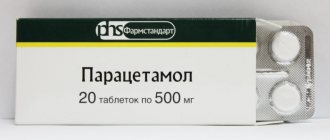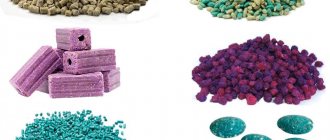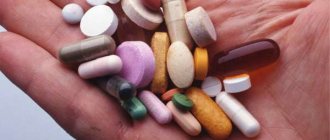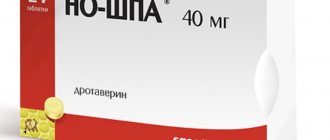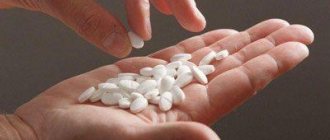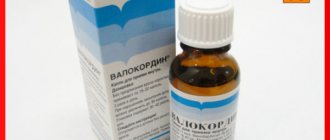Category: Drug poisoning
Phenobarbital poisoning poses a life-threatening risk. The drug has a cumulative effect, therefore, with prolonged use, it accumulates in the body and creates a load on the organs that eliminate toxins.
The state of intoxication during an overdose can be very severe and even result in the death of the patient. The victim must be immediately transported to a medical facility for first aid. Code according to ICD 10-T42.3.
Barbiturates are now available by prescription, so poisoning with them does not occur as often as before, when drugs in this group were sold freely. Most often it occurs due to overdose, suicide, drug addiction, or combining pills with alcohol.
Phenobarbital interaction
The drug reduces the antimicrobial activity of sulfonamides and antibiotics, as well as the antifungal effect of griseofulvin;
reduces the effectiveness of doxycycline, estrogens, corticosteroids, accelerating their destruction in the liver. Simultaneous use of Phenobarbital with atropine, belladonna extract, dextrose, thiamine, nicotinic acid, analeptics and psychostimulant drugs leads to a decrease in the hypnotic effect of the drug. The use of Phenobarbital in complex therapy with reserpine leads to a decrease in the anticonvulsant effect of the drug and an increase in the same effect under the influence of nialamide, diazepam, amitriptyline, and chlordiazepoxide.
Pharmacodynamics and pharmacokinetics
The mechanism of action of the drug can be traced at the cellular level. The component stimulates the receptors of the nervous system, changing the principles of metabolic processes and chemical reactions. The result is a decrease in the excitability of cell membranes, inhibition of nervous activity, and inhibition of impulse transmission between neurons.
The body's reaction to the use of the drug "Phenobarbital":
- relieving convulsive syndrome by blocking the appearance and propagation of nerve impulses;
- a decrease in the volume of free bilirubin in the blood against the background of changes in enzyme activity. This feature of the product allows you to stimulate the “cleaning” properties of the liver and improve the quality of its work during intoxication;
- weak analgesic effect, but an increased reaction to the stimulus is not excluded;
- reduction of nervous tension, feeling of calm, sleep. Achieved by suppressing sensory activity of areas of the cerebral cortex. Such sleep differs from physiological sleep in the shortening of some phases of the process. It occurs within 30-60 minutes, lasting on average 6-8 hours. When taken regularly, the therapeutic benefit of the product decreases after 10-14 days;
- sedative effect when using small doses of the drug;
- dulling the severity of signs of neurovegetative disorders when using the composition in combination with antispasmodics and/or vasodilators;
- an overdose of the active component provokes depression of the respiratory center in the brain, dulls its sensitivity to carbon dioxide, and reduces tidal volume;
- lowering blood pressure when using large doses;
- relieving increased tone of the smooth muscles of the digestive organs;
- slowing down the rate of metabolic processes;
- slight drop in body temperature.
After oral administration, the main component is absorbed in the small intestine, its maximum concentration in the blood is observed after 1-2 hours. The product is evenly distributed throughout the body; in the brain tissue its volume is minimal.
Elimination of the product takes several days, which creates a risk of accumulation of the substance or its metabolites in tissues. The half-life averages from 2 to 4 days for adults, up to 7 days for newborns. If kidney function is impaired, the substance stays in the body longer, which must be taken into account when selecting doses and drawing up a therapy schedule. The medicine is processed by liver tissue with the formation of inactive breakdown products. Up to 50% of the composition is excreted from the body unchanged, the rest is excreted in the urine.
In what dosages is the drug used?
The dose for the onset of a hypnotic effect is considered to be 0.2 grams. Luminal is prescribed only in cases where anxiety and agitation cause insomnia.
During epileptic and neurotic conditions, the dose of the drug should be 0.05-0.1 g. The maximum daily dose should not exceed 0.6 g, and the dose taken at a time is 0.4 g.
Phenobarbital overdose
A dose exceeding 0.5 grams is toxic and very dangerous. In this case, phenobarbital poisoning occurs. Death can occur if you take a dose of 2 to 10 g. At this moment, swelling of the brain and paralysis of the respiratory system occurs.
Instructions for use of Phenobarbital: method and dosage
The product annotation provides detailed information on the principles of therapy. Despite this, drug dosages should be selected by a doctor. They depend on the patient’s age, his physical condition, physiological characteristics, diagnosis, and expected results. Typically, the starting daily dose is the therapeutic minimum suitable for a particular case. It is increased only if there are no signs of positive dynamics.
Basic principles of using the medicine:
- for epilepsy - adults are given 50 mg twice a day. The dose is gradually increased until a volume that relieves seizures is established. The same schedule is provided for children, but doses are selected according to age. One-time volume for a baby less than 6 months. – 5 mg, up to one year – 10 mg, up to 2 years – 20 mg, up to 4 years – 30 mg, up to 6 years – 40 mg, up to 9 years – 50 mg, up to 14 years – 75 mg;
- The composition is taken orally 30-40 minutes before meals;
- Abrupt withdrawal from the drug for epilepsy threatens not only withdrawal syndrome, but also the development of status epilepticus and an increase in seizures;
- the maximum single dose of the drug for an adult is 200 mg, daily – 500 mg;
- for children under 3 years of age, the tablets are crushed into powder, which is diluted with a small amount of water to form a suspension;
- for problems with sleep, the drug is given to adults at a single dose of 100-200 mg 30-60 minutes before going to bed. The pediatric dose is selected according to age, starting from 5 mg;
- if there is an increased level of bilirubin in the blood, children under 12 years of age are given medicine at a rate of 3 to 8 mg per 1 kg of body weight per day for 3-5 days. Children over 12 years of age are prescribed 90-180 mg of the active ingredient. The therapeutic volume is divided into 2-3 approaches;
- as a premedication, the composition is given to patients older than 6 months, 1-3 mg per 1 kg of weight 60-90 minutes before manipulation.
For young children, the drug is often given in the form of a 0.2% solution for oral administration. In this case, you can ignore the meal schedule. In this case, standard dosages are used, unless otherwise provided by the treatment regimen.
Release form and composition
The main form of production and sale of the product is drops, which must be taken orally. The medicine is packaged in dropper bottles made of glass in a darkened form, followed by packaging in cardboard boxes. The container volume is 25 ml, 30 ml, 50 ml.
Drops in a volume of 1 ml include the following main components:
- Racemic solution of menthol in menthyl isovalerate – 80 mg. It has a calming effect with moderate vasodilating effects of a reflex type. Helps slow down the contraction of intestinal walls.
- Phenobarbital – 17 mg. It has a potentiating effect on the sedative effects of other components. Allows you to reduce the reactivity of the central nervous system and has a beneficial effect on the ability to fall asleep.
- Alpha-bromoisovaleric acid ethyl ester – 18 mg. This component has sedative and antispasmodic effects. They are implemented within the framework of a reflex circuit, i.e. are caused by a reflex formed under the influence of the active element on the nerve endings.
Additives from sodium acetate trihydrate are used as additional substances included in the composition. The composition contains rectified ethyl alcohol and water.
Sometimes the medicine is made in the form of white capsules with a butterfly pattern, but the image may be missing. The contents of the capsule are light powder. Capsules are packaged in blisters of 10 pcs. A paper pack may contain 1 or 2 blisters. Each capsule contains:
- components of menthol solution in the form of menthyl isovalerate – 46 mg;
- ethyl ether solution of alpha-bromoisovaleric acid – 10 mg;
- phenobarbital substance – 9.8 mg;
- additional elements in the form of castor oil, lactose monohydrate, microcrystalline cellulose with crospovidone, calcium stearate, silicon dioxide.
Overdose
Why is Phenobarbital especially dangerous? - high risk of overdose. The reason may be long-term use or overdosage due to addiction.
Symptoms of an overdose of Phenobarbital are as follows:
- severe dizziness;
- vomiting, nausea;
- salivation;
- hiccups;
- rare breathing intermittently;
- skin cyanosis;
- constriction of the pupils, followed by dilation.
- euphoria;
- slurred speech;
- impaired coordination of movements;
- uncontrollable urges.
In this condition, the consequence of an overdose of Phenobarbital in young people is often criminal or immoral behavior. As you get older, your risk of fractures and injuries increases. A car driver may cause an accident after an overdose. After all, his reactions become inhibited.
An overdose of Phenobarbital can cause death. A single toxic dose is 0.5–0.75 g. The lethal dose of Phenobarbital starts from 2 g, in some people - 8–10 g. This depends on the person’s tolerance (resistance) to the drug.
Causes of overdose
In case of overdose, the danger of the drug is severe poisoning of the body. This occurs in the following situations.
- Patients with constant use develop addiction. To achieve a therapeutic or narcotic effect, people increase the amount of the drug they take.
- Taking a large number of pills for the purpose of suicide.
- Overdose in people with barbiturate addiction due to addiction.
With further progression, the patient falls into a coma.
First aid
In case of Phenobarbital poisoning, urgent measures are needed. With mild intoxication, you can alleviate a person’s condition at home.
First aid for Phenobarbital poisoning consists of the following steps.
- Washing the stomach twice with warm water - 1 tbsp for 1 liter. l. salt. To induce vomiting, you need to press on the root of the tongue.
- Dissolve 30–50 g of crushed activated carbon in water, drink and induce vomiting after 10 minutes.
- Give a diuretic while taking fluids.
- If the person is unconscious, lay him on his side and call an ambulance.
How to neutralize Phenobarbital? - There is no special antidote. But the antagonist of barbiturates is the drug Bemegride, which will restore respiratory and circulatory depression and stimulate the nervous system.
Treatment
Therapy comes down to removing the drug from the body. Treatment for Phenobarbital poisoning is carried out by doctors in a hospital:
- tube gastric lavage;
- forced diuresis;
- intravenous administration of alkaline solutions to accelerate the elimination of Phenobarbital;
- laxatives;
- if a person is unconscious, then he is connected to an artificial respiration apparatus;
- anti-shock measures.
In case of acute renal failure, hemodialysis or peritoneal dialysis is prescribed.
What to do in case of overdose
If a person taking Andipal begins to feel unwell, poisoning with this drug should be suspected. Call an ambulance immediately. Treating this condition on your own is very dangerous .
After calling the doctors, begin providing first aid to the poisoned person. Below are the main actions you can take to alleviate his condition:
- Remove any remaining drug from the stomach. To do this, the patient needs to drink several glasses of plain water in one gulp and induce vomiting. This procedure is not performed if consciousness is impaired or dark vomit appears .
- Give the patient sorbents to drink. This can be activated carbon, polysorb, smecta, enterosgel, etc. The rules for their dosage are indicated on the packaging.
- Before the doctors arrive, constantly give the poisoned person drinking plain or mineral water.
Effect of phenobarbital in overdose
The most serious consequence of an overdose of phenobarbital is the destruction of the main nerve canals. This manifests itself as restlessness when a person is in constant motion, like a pendulum. He cannot sit, lie down, tramples from foot to foot, constantly makes uncontrolled movements, and experiences a feeling of anxiety.
Over time, the central nerve canals completely atrophy. But nerve impulses are forced to find alternative paths to move through the body. Thus, people experience involuntary facial contractions, the tongue falls out, profuse salivation appears, and limbs twitch.
At high doses, the respiratory center in the brain is depressed, reducing the volume of inhaled air.
Signs of drug poisoning
Phenobarbital poisoning can be acute or chronic. The toxic dose for humans has not been precisely established. It varies depending on age and physical condition. Taking 1 gram once in adults causes acute poisoning. The lethal dose ranges from 2 to 10 g.
Chronic poisoning
Symptoms of chronic intoxication:
- from the gastrointestinal tract - dry mouth, constipation;
- from the nervous system - drowsiness or lack of sleep, blurred vision, dizziness, confused speech, convulsions, imbalance;
- from the psyche - apathy, hallucinations, agitation, confusion, irritability, inadequate attitude to criticism, depression, fears, anxiety.
Chronic poisoning impairs urination and increases body weight. Regular use of the drug causes menstrual irregularities in women and leads to impotence in men.
Acute poisoning
- hallucinations, delusions;
- severe confusion;
- unusual eye movements, high rhythm of eyeball movements;
- motility disorders, muscle weakness, inconsistency of muscle function;
- slurred, unintelligible speech;
- lack of reflexes;
- headache.
- respiratory depression;
- slower urine production (a sign of kidney damage);
- rapid heartbeat, weak pulse;
- decreased blood pressure and body temperature;
- the skin is clammy and cold with a blue tint;
- when pressed, subcutaneous hemorrhages.
In case of severe phenobarbital overdose, consequences develop: pulmonary edema, coma, cardiac and respiratory arrest. Death occurs.
After acute poisoning, the following complications often develop:
- pneumonia;
- chronic heart and kidney failure;
- disturbance of heart rhythms.
Video: doctor's reviews of the drug Phenobarbital
Read further:
How long does alcohol intoxication and hangover last for the body ❶ ❷ ❸
The therapeutic community is a path to health
How long does food poisoning last in adults and children?
Toxic substances of psychochemical action - signs of human damage
Blepharoplasty: indications and features of the procedure
Article rating:
( 1 ratings, average: 5.00 out of 5)
Share with friends:
You may also be interested in:
What to do in case of overdose (poisoning) of Ascorutin for adults and children
What to do in case of overdose of furosemide: symptoms and consequences
Diclofenac overdose: symptoms and consequences of poisoning
Consequences of afobazole overdose ✅ - symptoms and treatment
Contraindications
The manufacturer cites a lot of conditions in which it is better to refrain from using the product. If the patient has relative inhibitions, therapy is recommended to be carried out under the supervision of a physician. If possible, with any restrictions, the drug is replaced with an analogue from the corresponding therapeutic group.
List of absolute contraindications to the use of the medicine:
- violent reaction of the body to the main component, increased sensitivity to any barbiturates;
- severe decreased performance of the kidneys and/or liver;
- metabolic problems, for example, diabetes, damage to the thyroid gland, adrenal glands;
- first trimester of pregnancy – there is a high risk of impaired embryo development;
- breast-feeding;
- myasthenia gravis of any severity;
- porphyria in medical history;
- chronic alcoholism, drug addiction in the active phase or history;
- severe anemia;
- respiratory diseases, which are accompanied by shortness of breath and bronchial obstruction.
Separately, there are a number of conditions in which treatment requires special care. Persons with depression, a history of suicide attempts, bronchial asthma, and hyperkinesis need increased attention from doctors.
A decrease in kidney and/or liver function should be accompanied by dosage adjustments. Pregnant women (II and III trimesters) and children of any age are usually treated under the supervision of medical personnel. The medication is not recommended for patients with persistent or acute pain.
special instructions
The drug should not be taken during pregnancy
When using Barboval, it is necessary to take into account the features of drug interactions:
- its effect is enhanced when combined with antipsychotics, tranquilizers, and sedatives;
- weakening is observed under the influence of neurostimulants;
- due to the action of the drug, the therapeutic effectiveness of drugs with hypotensive, hypnotic, local anesthetic effects, as well as analgesics, increases;
- long-term co-administration with NSAIDs creates a risk of the occurrence and progression of gastric ulcers and bleeding;
- the risks of impaired renal function increase when used together with gold preparations;
- in interaction with alcohol, the effectiveness of Barboval’s components is enhanced, and greater toxicity is manifested;
- the medicine can increase the toxicity level of methotrexate;
- under the influence of Barboval, the degree of effectiveness of drugs that are metabolized in the liver decreases.
Use during pregnancy and lactation
The instructions indicate the inadmissibility of using Barboval during pregnancy or breastfeeding.
For children
The drug is not used in pediatric practice. It is not prescribed to patients under the age of 18 years.
Use while driving
The drug contains phenobarbital with 62% ethanol. Therefore, Barboval can reduce the speed of psychomotor reaction and impair coordination. These reasons suggest the need to be careful when driving vehicles and complex machinery. During the treatment period, it is advisable to refrain from using transport.
Alcohol compatibility
The effect of alcohol enhances the effect of the drug, while increasing its toxicity. Drinking alcohol during the course of treatment is not recommended.
History of creation
Emil Fischer
Barbiturates were first created in 1904 by the German chemist Emil Fischer. After 2 years, a drug was produced - Phenobarbital.
The Bayer company released the first drug containing Phenobarbital in 1912 under the trade name Luminal. At that time, in the absence of other anticonvulsant and anti-anxiety medications, it was considered harmless and was popular until the 1960s. By that time, practical medicine had already accumulated a lot of facts about its side effects.
Widespread consumption of Phenobarbital has led to the emergence of a large number of dependent and abusing people. This prompted pharmacologists to create safer sedative and anticonvulsant drugs.
Other names
The discovery of barbituric acid was made in 1864 by Adolf von Bayer. In 1904, phenobarbital was released as Veronal. They have received official recognition in medicine as a pacifying product with a deep soporific effect. Initially intended to calm violent people in psychological clinics. Later became known as "Luminal" thanks to.
After gaining popularity, the drug began to be classified as a narcotic psychotropic substance. The strong sedative effect has led to off-label use, despite the high likelihood of overdose. Phenobarbital is also found in over-the-counter medications:
- Valoferin;
- Corvaldin;
- Corvalol;
- Lavocordin;
- Pentalgin-N;
- Piralgin;
- Tetralgin.
Use during pregnancy and lactation
Phenobarbital is contraindicated for use in the first trimester of pregnancy due to possible teratogenic effects. In the second and third trimester, the use of the drug is possible only for health reasons, if the prescription of other drugs is impossible.
When barbiturates are used by pregnant women, the incidence of fetal abnormalities increases.
Newborns born to women who took the drug in the third trimester of pregnancy may develop withdrawal syndrome and physical dependence.
There is evidence that Phenobarbital, used by women during pregnancy as an anti-convulsant, caused blood clotting disorders in newborns (increasing the likelihood of bleeding in the child in the first days after birth).
Use of the drug during childbirth increases the risk of respiratory depression in a newborn, especially a premature one.
If it is necessary to use Phenobarbital during lactation, breastfeeding should be discontinued.
It is advisable to prescribe the drug to newborns with hemolytic disease, since it reduces the concentration of bilirubin in the serum.
How does dependence on phenobarbital occur?
Psychiatrist-narcologist Minicheva I. speaks about this: “Almost every drug that acts on the central nervous system is a drug, as it leads to mental and then physical dependence. And it all starts with increasing the dose - the previous one “doesn’t take” and “doesn’t catch on.” ... Habituation and dependence on phenobarbital develops within 2-3 weeks of regular use.” And then the drug addict does not care how much phenobarbital costs and that it is a sleeping pill.
Minicheva also warns: “Do not take medications without a doctor’s prescription! Separately, I would like to address drivers and driver candidates: almost no one knows that phenobarbital is contained in Corvalol and Valocordin, which are not usually considered sleeping pills. Often, a person, having taken Corvalol or Valocordin, gets behind the wheel without fear.”
Doctors’ reviews of phenobarbital also speak of addiction: “it’s addictive,” “causes quite serious impairments in memory and concentration,” and “a lot of severe side effects.”
Legislation in the field of Phenobarbital circulation
The drug has a strong effect on the human nervous system and is therefore subject to the following restrictions.
- “Phenobarbital” belongs to the list of narcotic and psychotropic substances, as well as their precursors, which are subject to control in Russia, according to Decree of the Government of the Russian Federation No. 78 of 02.2013.
- Phenobarbital is a psychotropic drug. Therefore, it is stored in medical institutions according to list “B” in a safe under lock and key with the inscription “potent”.
- It is included in List III - psychotropic substances with restricted circulation in the Russian Federation.
- According to the Convention on Psychotropic Substances, Phenobarbital is included in Schedule IV. This means that medicines containing phenobarbital are prohibited for import into the UAE, America and Lithuania. Customs services have been informed about this.
- By order of the Russian Ministry of Health dated July 14, 2003 No. 308, a medical examination of drivers is carried out for intoxication. According to the resolution, if any amount of Phenobarbital is detected in the blood or urine, the person driving the vehicle is recognized as being in a state of drug intoxication and is deprived of his license. Don’t forget that the medicine stays in the body for up to 4 days!
- The drug is available at the pharmacy only with a prescription.
- “Phenobarbital” is included in the list of vital medicinal substances according to the Decree of the Government of the Russian Federation dated December 7, 2011.
Is this medicine a drug
Phenobarbital is a drug with a long half-life. Therefore, drug addicts do not consider this drug popular enough. However, in the Russian Federation this medicine is included in the list of psychotropic and narcotic substances.
The danger of the drug is that in order to obtain a narcotic dose reminiscent of alcohol intoxication, it is necessary to take a lethal dose. And the narcotic effect after taking the drug will cause a long-term hypnotic effect. Within a month or two, a person gets used to the medicine, he develops mental, and then physical dependence and, by increasing the dose, he can die from an overdose.
Phenobarbital analogues
The following analogues of Phenobarbital in composition are available on the Russian market:
- "Luminal";
- "Dormiral";
- "Barbital".
According to pharmacological action, there are 95 group analogues.
Phenobarbital is used in medicine mainly as an antiepileptic drug. It must be remembered that over-the-counter drugs based on barbiturates form dependence, reduce memory, and impair the effectiveness of other drugs. Rapid addiction to Phenobarbital requires increasing the dose or frequency of administration. This creates a risk of overdose and poisoning.
SIGN UP FOR A FREE CONSULTATION
We will help motivate a person so that he has a desire to get rid of addiction. We will give recommendations on how to communicate with a drug addict.
Back in 1863, a drug based on barbituric acid created a real sensation. Barbital was able to control the inappropriate behavior of citizens, fight stress, insomnia, and perfectly calm people down. The drug became so popular that soon many people became addicted to it.
Phenobarbital overdose
Addiction and withdrawal symptoms are not the only dangers of barbiturate. When taking it, there is a possibility of developing chronic toxic poisoning or acute overdose. If 1 g of the active substance enters the body, serious negative consequences are possible. For an adult, 2 g of the drug is a potentially lethal dose.
The acute condition is characterized by ataxia, confusion, headache, severe weakness and drowsiness or extreme agitation. The patient experiences oliguria, decreased blood pressure, a drop in body temperature, slow pulse, and cyanosis. In the absence of timely medical care, the pupils narrow, reflexes weaken or disappear, the pulse weakens, and bruises appear at pressure points on the skin. Severe poisoning leads to apnea, collapse, coma, and death due to cardiac or respiratory arrest.
Intoxication due to a barbiturate overdose can take on the appearance of clinical death, which is explained by the suppression of the electrical activity of the brain
In this case, it is important to make a correct diagnosis. If not much time has passed since the development of the emergency condition, and hypoxia has not led to irreversible changes in the brain matter, then the phenomenon is completely reversible
Chronic Phenobarbital poisoning is characterized by bad mood, apathy, irritability, sleep problems, and decreased intelligence. Victims often complain of dizziness, problems with coordination, poor balance, general weakness, confusion of speech, and drowsiness. In advanced cases, convulsions, hallucinations, and malfunctions of the digestive tract, heart, blood vessels, and kidneys occur.
There is no special antidote that neutralizes the effect of the drug. As first aid in case of acute overdose, it is necessary to remove Phenobarbital from the body as quickly as possible. Additionally, symptomatic therapy is provided according to indications. After performing manipulations aimed at stabilizing the vital functions of the body, the victim is transported to the hospital.
Principles of treating a patient with an overdose of Phenobarbital:
- preventing further absorption of the active substance by inducing vomiting and gastric lavage;
- taking activated carbon, laxative saline and alkaline solutions, performing forced diuresis;
- normalization of blood pressure, prevention of airway blockage, oxygen supply if necessary;
- carrying out anti-shock measures in severe condition of the patient;
- preventing oversaturation of the body with sodium or fluid;
- hemodialysis for life-threatening intoxication.
After the patient is brought out of critical condition, the activities are not completed. An overdose of barbiturate can cause congestive heart failure, pneumonia, kidney problems, and heart rhythm disturbances. Chronic drug poisoning is treated by gradually eliminating the product. If necessary, symptomatic therapy is carried out.
First aid for intoxication
Overdose is a dangerous condition that can be fatal. First aid for intoxication includes:
- breathing support;
- taking activated carbon to prevent drug absorption;
- the use of laxatives to remove phenobarbital components;
- intravenous administration of saline.
Attention! If the patient falls into a coma or experiences life-threatening symptoms, an ambulance must be called immediately.
- hives;
- difficulty breathing;
- swelling.
Indications for use of Phenobarbital
According to the instructions, there are the following indications for the use of Phenobarbital:
- epilepsy;
- hyperbilirubinemia;
- spasms of peripheral arteries and spastic paralysis;
- congenital non-hemolytic unconjugated hyperbilirubinemia;
- chronic intrahepatic cholestasis;
- insomnia, tension, anxiety, fear, agitation, convulsions of various origins, tremor;
- alcohol withdrawal;
- encephalitis caused by influenza, measles, rubella, chickenpox, whooping cough and mononucleosis;
- neurovegetative disorders;
- generalized tonic-clonic seizures;
- focal seizures in children and adults.
Contraindications to the use of phenobarbital
The drug is contraindicated in the following diseases and conditions:
- Hypersensitivity and allergic reactions to barbiturates.
An allergy to the drug is a logical contraindication. Repeated use of the drug can cause serious reactions such as anaphylactic shock and Quincke's edema. They threaten human life and may require urgent assistance. - Porphyria.
Porphyria is a hereditary disorder of pigment metabolism, which may be aggravated when taking phenobarbital.
This is due to the fact that the drug activates enzymes that synthesize porphyrin ( a pigment whose content is increased in this disease
).
- Severe anemia.
When using the drug, blood pressure decreases.
Anemia ( reduced number of red blood cells in the blood
) is almost always compensated for by increased blood pressure to maintain oxygen supply to organs and systems. The use of the drug disrupts this compensatory mechanism. - Severe breathing disorders and shortness of breath.
Phenobarbital suppresses the respiratory center, causing a decrease in breathing rate. As a result, the human body may suffer from a lack of oxygen, which can lead to serious disruptions in its functioning. - Liver or kidney failure.
In case of severe impairment of renal or hepatic activity, the effect of the drug is noticeably prolonged and it becomes toxic. The effect of inhibition of the central nervous system can last more than a day, which is unacceptable. - Myasthenia.
This drug inhibits the motor areas of the cerebral cortex, so its use for muscle weakness can significantly worsen the condition. - Alcoholism, as well as other drug or drug addiction.
The drug is a psychotropic substance, therefore its use in a group of patients suffering from any addiction is strictly prohibited. This drug may be addictive.
In what cases should the use of the drug be limited?
The drug should be used with caution in case of the following conditions or diseases:
- Depression, sudden mood changes, suicidal tendencies.
The drug can affect a person’s mental health in the most unexpected ways, most often negatively. With psychological instability, the risk of this phenomenon increases. - History of liver and kidney diseases.
Any disruption of these organs could theoretically reduce the rate at which the substance is eliminated from the body. - Hyperthyroidism.
Barbiturates are transported by plasma proteins, as are thyroid hormones (
thyroxine
). Taking phenobarbital displaces thyroxine from binding to plasma proteins, which can cause symptoms of intoxication with this substance to suddenly appear. - Hypofunction of the adrenal glands.
When using phenobarbital, the systemic effect of adrenal hormones is reduced, which worsens the course of this disease. - The presence of acute or chronic pain.
The drug does not eliminate the source of pain, it changes its perception by the central nervous system. Thus, important symptoms of the disease may be hidden or the time during which the underlying disease will progress may be lost.
Can the drug be used during pregnancy? Does the drug pass into breast milk?
During pregnancy, the highest concentrations are found in the liver and brain due to a deficiency of vitamin K, which is synthesized in the liver
breast milk breastfeeding
How to take pills so as not to get poisoned?
In order not to get poisoned while taking the drug, you must follow all the doctor’s recommendations and follow certain rules:
- Do not take a large number of tablets at once.
- Combine the tablets correctly.
- Different drugs should not be taken together.
- Do not use expired medications.
- Follow all your doctor's instructions.
- Before taking the tablets, carefully read the instructions for use.
- During the treatment of various diseases, different specialists prescribe drugs that are not compatible with each other. None of these drugs can be stopped. Therefore, before taking it, you need to visit a therapist who will distribute the medications and draw up the correct dosage regimen. If necessary, replace one drug with another, which will be combined with Andipal.
- Medicines must be stored strictly as prescribed. Never leave medications in the bathroom or freeze syrups. Any medicine should be kept away from children and avoid direct exposure to sunlight.
Andipal is an effective drug that can be useful for many diseases. But do not forget that any medicine should be taken only after consultation with your doctor. If during administration the first signs of an overdose appear, immediately call an ambulance and do not ignore the advice of specialists.
Drug interactions
When used simultaneously with drugs that have a depressant effect on the central nervous system, with ethanol or ethanol-containing drugs, the depressant effect on the central nervous system may be enhanced.
When used simultaneously with MAO inhibitors and methylphenidate, it is possible to increase the concentration of phenobarbital in the blood plasma, which can lead to toxic effects and increased inhibitory effects on the central nervous system.
With the simultaneous use of GCS, corticotropin, chloramphenicol, cyclosporine, dacarbazine, digitalis glycosides, metronidazole, quinidine, carbamazepine and anticonvulsants from the succinimid group, estrogen-containing oral contraceptives, anticoagulants - derivatives of coumarin and indandione, tricyclic antidepressants, doxycycline, fenoprofen, chlorine promazine, phenylbutazone, Vitamin D, xanthines may reduce the intensity and duration of action of these drugs due to increased metabolism, which is due to the induction of microsomal liver enzymes under the influence of phenobarbital.
With simultaneous use, it is possible to slow down the absorption of phenobarbital from the intestine.
When used simultaneously with acetazolamide, osteomalacia and rickets are possible.
When used simultaneously with valproic acid, the concentration of phenobarbital in the blood plasma increases, which may be accompanied by severe sedation and lethargy. A slight decrease in plasma concentrations of valproic acid has been reported.
With simultaneous use, the plasma concentration of verapamil, nimodipine, and felodipine decreases.
When used simultaneously with halothane, enflurane, fluorothane, methoxyflurane, it is possible to increase the metabolism of anesthetic agents, which increases the risk of toxic effects on the liver, and in the case of methoxyflurane, on the liver and kidneys.
When used simultaneously with griseofulvin, the absorption of griseofulvin from the intestine may be reduced; with caffeine - the hypnotic effect of phenobarbital is reduced.
When used concomitantly with maprotiline, in addition to a possible depressant effect on the central nervous system, maprotiline in high doses can lower the seizure threshold and reduce the anticonvulsant effect of barbiturates.
When used simultaneously with paracetamol in patients receiving phenobarbital, the effectiveness of paracetamol may be reduced. Cases of hepatotoxicity have been described.
With simultaneous administration of pyridoxine at a dose of 200 mg/day, a decrease in the concentration of phenobarbital in the blood plasma is possible.
With the simultaneous use of primidone and felbamate, an increase in the concentration of phenobarbital in the blood plasma is possible.
When treating folic acid deficiency, the use of folic acid preparations reduces the effectiveness of phenobarbital.
Effect of phenobarbital at therapeutic concentrations
The tablets have three directions of action:
- anticonvulsant – prescribed to patients with epilepsy;
- sedative – used for acute mental disorders;
- sleeping pills – used for therapeutic purposes to improve the quality and duration of sleep.
The substance reduces the excitability of nerve cells and disrupts their normal functionality. The transmission of impulses between neurons is inhibited. The drug, affecting the cerebral cortex, causes drowsiness, reduces motor activity, and calms the nervous system.
The hypnotic effect occurs after 30 minutes, less often after an hour. Sleep lasts 7-8 hours. After two weeks of taking the drug, the effect decreases noticeably.
In therapeutic doses, it has a calming effect and eliminates neurovegetative disorders:
- hot flash;
- red spots on the skin of the chest and neck;
- attacks of rapid breathing and heart palpitations;
- low blood pressure.
In small doses, it does not affect the functioning of the cardiovascular system or kidneys, and slightly reduces metabolism and body temperature.
Prices and terms of sale in pharmacies
The average price for a standard 25 ml package is 50-75 rubles. Available without a prescription.
Table of current prices for the drug Barboval
in online pharmacies. Data was last updated on 09/14/2020 00:05.
| Pharmacy | Name | Price | |
| ZdravCity | Barboval drops fl. 25ml | 112.00 | BUY |
Treatment of poisoning
The treatment tactics for acute and chronic poisoning are radically different.
In case of chronic intoxication, the patient gradually reduces the dose so that withdrawal syndrome (“withdrawal”) does not develop, until the drug is completely discontinued. At the same time, symptomatic therapy is prescribed and psychiatric care and support is provided.
Treatment of acute intoxication is aimed at quickly removing the drug from the body and maintaining the vital functions of organs and systems.
Emergency help consists of quickly reducing the concentration of the substance. If the drug has not yet been absorbed into the gastrointestinal tract, the following measures are taken:
- cause artificial vomiting if the person is conscious and responds to calls to him;
- perform gastric lavage if the victim is unconscious or in a state of acute psychosis;
- give activated carbon tablets to drink;
- diuretics and large amounts of fluid are prescribed to quickly cleanse the blood (if kidney function is not impaired).
Respiration, cardiac and brain activity, and water balance are monitored continuously until the condition improves and stabilizes.
As maintenance therapy, a ventilator with oxygen is used, and medications are prescribed that increase blood pressure and body temperature. If necessary, anti-shock therapy and connection to an artificial kidney machine.
Alcohol compatibility
Taking the drug with alcohol is prohibited. This is due to the fact that the elimination of the drug occurs very slowly, the average withdrawal time exceeds 7 days. When drinking alcohol, especially in large doses, it leads to severe poisoning. Symptoms of incipient poisoning when drinking alcohol or exceeding the dosage are:
- impairment of breathing and speech,
- nausea and vomiting,
- obsessive state of fear,
- disorder of consciousness,
- decrease in pressure and temperature,
- absence or decreased sensitivity.
We recommend reading: A child has a toothache: how to relieve the pain: what to do
When these symptoms appear, the victim needs urgent help; time counts down to minutes.
Use as a drug
Phenobarbital as a drug is especially popular among addicts. It is cheap and available as part of the combination drug Corvalol. Barbiturate addicts obtain Phenobarbital powder by evaporating it from a tincture. After just 2 weeks of regular use, physical dependence develops. Tolerance quickly develops to Phenobarbital, which is why drug addicts increase the dose, risking an overdose. In this case, poisoning often occurs with a fatal outcome.
Barbiturate addiction changes a person's personality. His behavior becomes aggressive, he is unable to control his actions. The appearance of a drug addict using Phenobarbital also suffers:
- pale skin;
- many pustules on the body;
- coated tongue;
- earthy color of pasty face;
- long-term non-healing wounds;
- dull look;
- brittle hair.
Barbiturate addiction is difficult to treat - a person cannot stop taking the drug without suffering (withdrawal syndrome).
Adverse reactions
Even without an overdose, the following adverse reactions may occur due to treatment with Phenobarbital:
- coordination disorder, dizziness, impotence, fainting, excessive arousal, lethargy, anxiety, tremors of the upper limbs, irritability, headache, drowsiness, lethargic sleep, respiratory depression, hallucinations, depression, nightmares, problems with thinking, hyperkinesia, an aftereffect that manifested by lethargy, weakened concentration, slow psychomotor reaction,
- rickets, disorder of bone formation,
- vomiting, stool retention, liver dysfunction,
- hypotension, collapse,
- reduction of all blood elements,
- allergies, death from Phenobarbital is possible,
- drug addiction.
If you stop taking the drug abruptly, phenobarbital withdrawal symptoms appear:
- headache, nightmares, difficulty falling asleep, drowsiness, anxiety, restlessness, vertigo, hand tremors, muscle twitching, convulsions, hallucinations,
- vision problems,
- nausea, vomiting,
- pressure drop,
- lack of folate, decreased calcium levels in the blood,
- weakened libido, erectile dysfunction.
